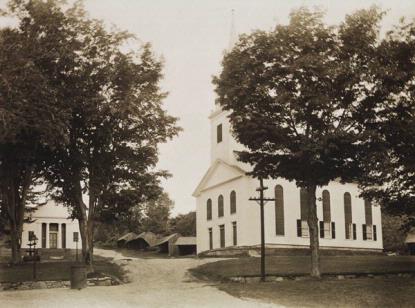
A single black and white photograph. The familiar New England scene depicts the center of Westhampton at the turn of the twentieth century. The white church and town hall, three tall trees and a little grassy knoll with a cast iron fountain and a bench. The fountain, a gift to the town from a member of one of its oldest families, eventually lost the uppermost of its three tiers due to a fallen tree branch. Even with the aid of a magnifying glass, it is hard to discern if all three tiers are intact in the photograph because the fountain’s center was perfectly aligned with a lamp post. A lamp post? There was a lantern in the center of town? Yet another can be seen close to the steps of the town hall. They appear to be a matched set. The front steps of the town hall don’t look familiar. I only see one set of steps, yet I’ve always known there to be two sets. And that door! The town hall door in the picture is not at all familiar to me.
To the right of the fountain stands the church, its tall steeple lost in the same whiteness of the sky. A nearby row of sagging wooden horse barns appear to be connected. I count six roofs. In the forefront of the photo is a watering trough at the intersection of four roads, all unpaved.
What is missing in the photograph, in all photographs, is the three dimensional world behind and beyond it. Just as an artist fills her blank canvas and then creates or “builds” a picture, the earliest residents chose this particular spot upon which to build their little town square. Over the course of a hundred years they constructed and then mourned the loss of two previous churches on the same site. They had trained as revolutionary and civil war militia members on that same knoll. They voted in that hall. They planted those trees. Those who dared to dream it, who worked toward its culmination, would never live to see their picture completed. The same picture we recently unearthed in our museum.


